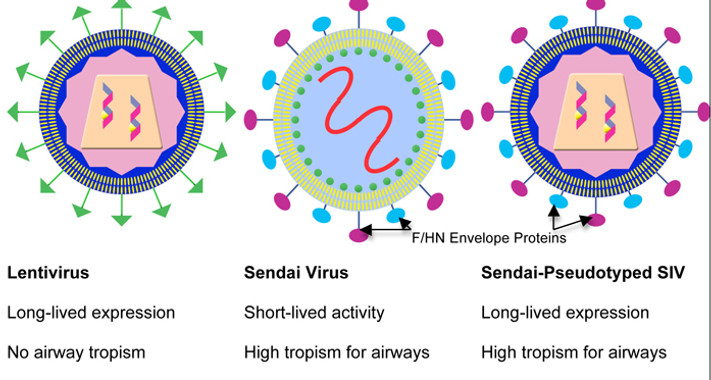Lentiviral Vector Development
Recombinant viral vectors are gene therapy vectors which are derived from viruses. Many viruses such as adenovirus, adeno-associated virus & Sendai virus have evolved over millions of years to become efficient agents at infecting human airway cells.
Using an array of molecular biology tools, methods have been developed to allow virus particles to be modified such that they contain no infectious material or replicative capacity. Instead they package a gene therapy construct within their viral structure. In this way it is hoped to use the virus' ability to get into cells and deliver a therapeutic gene.
These methods have been heavily investigated for CF gene therapy and indeed most CF gene therapy trials conducted to date have used viral vectors. However, viral vectors induce an immune response from the host (human) organism. Their viral particles are recognised as foreign material. This neutralising antibody response means that to date no viral vector has been successfully repeat administered without loss of activity.
For several years now the Consortium has been collaborating with DNAVEC, a Japanese Biotech company, to develop a new viral vector platform for CF gene therapy. Lentivirus-based vectors hold the promise of long duration of gene expression and low immunogenicity and are therefore particularly attractive for airway gene therapy. However, previously it had been shown that the traditionally used Lentivirus envelope (VSVG-pseudotype) was inefficient at transducing the airway epithelium, unless the epithelium had been deliberately damaged, or had the epithelial tight junctions opened to provide access to the virus.
As an alternative, DNAVEC proposed to pseudotype the lentivirus vector with the F and HN proteins from Sendai Virus (Kobyashi et al 2003) to increase the efficiency of airway transduction without the need for pre-conditioning agents to damage the epithelium. In close collaboration with DNAVEC, the Consortium assessed the novel F/HN-pseudotyped lentivirus in mice in-vivo and in various ex-vivo lung models.
We have shown that (Mitomo et al 2010 & Griesenbach et al 2010):
-
The SIV-F/HN vector can transduce the respiratory epithelium of the murine airways via the apical membrane in-vivo at levels that may be relevant for clinical benefit in CF
-
This can be achieved in a single formulation and without the need for pre-conditioning with additional chemicals
-
Stable expression levels can be achieved for the life-time of the mouse
-
Re-administration to nasal epithelium and lung is feasible
-
The SIV-F/HN vector can transduce human air-liquid interface (ALI) cultures and generate stable, long-term gene expression
-
The SIV-F/HN vector transduces human lung slices ex vivo and functional CFTR chloride channels can be generated invitro
The Consortium's enthusiasm for developing lentiviral vectors for CF gene therapy further is based on several important findings: firstly, in every model studied so far, the levels of lentivirus-mediated gene transfer are log-orders higher than the current Wave 1 product.
Secondly, lentiviruses integrate into the cell genome, which leads to prolonged and stable expression (in mice for the lifetime of the animal after a single dose). Finally, the virus does not induce an effective immune response after repeat administration. Based on these data the Consortium has entered into a major tripartite agreement with Boehringer Ingelheim and Oxford BioMedica to develop this lentivirus for clinical trials.

A Sendai-Pseudotyped SIV vector combines the long-lived transgene expression characteristics of SIV with the efficient airway cell tropism of Sendai Virus
